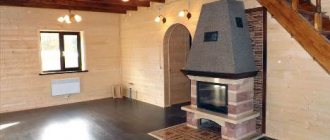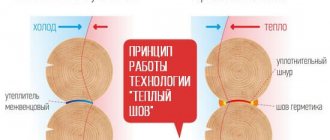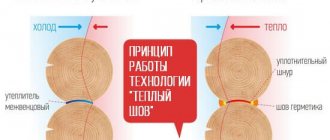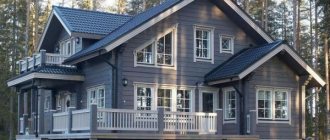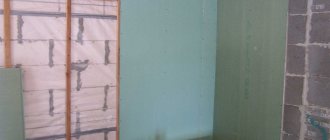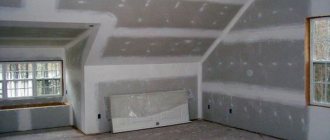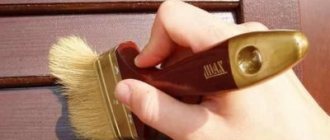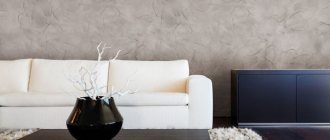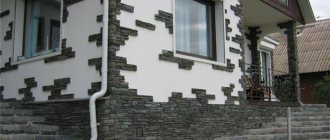What paint can you paint a wooden house?
The question of which paint is best to paint the outside of a wooden house is far from idle.
The choice of paint for the facade of a wooden house is a determining factor that determines how long the coating will last and how the wooden structure will look. Paints for exterior painting must meet the following requirements:
- provide protection of wood from atmospheric agents;
- protect the structure from UV radiation;
- have a high level of moisture resistance;
- ensure color preservation for a long time.
There are several types of painting compositions that can be used to coat the external walls of a log house (including rounded logs), timber houses, and also to paint a frame house. To determine how to cover the outside of a timber house and understand what is better, impregnation or paint, to paint a wooden house so that it does not peel off and retains its original appearance for a long time, you need to get acquainted with the characteristics of each product.
Acrylic paints
- They have good resistance to atmospheric conditions.
- Protect wood from exposure to ultraviolet radiation.
- They create an elastic film on the surface that does not form cracks during wood shrinkage.
- They allow air to pass through and do not interfere with air exchange processes occurring in the wood.
- They dry very quickly, the specific time depends on the type and moisture content of the lumber.
- They form a durable coating that retains its original color and does not lose its aesthetic characteristics for 8-10 years.
Acrylic paints are quite expensive. Instead, you can use inexpensive acrylate dyes for a log house, which have similar characteristics. The difference between them is that in the first case the composition contains only concentrated compounds without any impurities. In the second, additives are used: acrylate-copolymer dispersions, which reduce the cost of paint.
Oil based paints
- They are distinguished by a very high degree of resistance to precipitation.
- Provide reliable protection of wood from moisture penetration.
- They have excellent penetrating ability and are perfectly absorbed by wood.
- They form a beautiful glossy finish that will last about six years.
The only drawback that oil-based façade paint for a wooden house has is that it takes quite a long time to dry. The drying speed of this paint is about a day.
Antiseptic impregnations
Antiseptic compositions are divided into:
- Glazing. They form a transparent coating that preserves and enhances the beauty of natural wood.
- Toning. The wood is painted in the chosen color, while completely preserving the natural relief of the wood.
Varnishes, waxes and stains
- Wax is absorbed very well into wood and protects it from moisture and dirt. After waxing, the surface of the imitation timber will acquire a beautiful matte shine.
- Stain protects the surface from fungus and various pests, but this product alone is clearly not enough, such a coating will be short-lived. How to treat the outside of the lining after applying the stain? It is best to apply varnish on top, which will enhance the protective properties and extend the service life of the coating.
- Clear or colored varnishes are great for painting a house made of laminated veneer lumber. In both cases, the natural relief of natural wood will remain visible; colored varnish will only change its shade.
How to process
All types of protective coatings that can be used for internal treatment of a log house can be divided into two types:
| Type | Peculiarities |
| Penetrating | They penetrate into the structure of wood, where they close its pores, and also have some other effects on the material. |
| Superficial | They are all kinds of paint and varnish coatings that form a durable film on the surface of wood that protects the material from moisture and other negative influences. |
Note! Any coatings, regardless of their type, can be used for the designated purposes only if they are intended for interior use. This information is always contained in the instructions on the packaging.
Below we will take a closer look at each type of these funds.
Decorative impregnation for interior work
Penetrating compounds
Penetrating compounds primarily include impregnations.
As a rule, these are complex preparations that provide wood with the following protection:
- from biological influences, which include microorganisms, fungi, parasitic insects and even rodents;
- from moisture - as a rule, the compositions are made on the basis of oil or wax, which fills the pores of the wood and thereby prevents the penetration of water;
- fire – the presence of a fire retardant in the composition protects the tree from fire.
Protective impregnation for pre-treatment
Also, depending on the purpose of impregnation, they are divided into the following types:
- decorative – are a finishing coating, most often giving the wood a certain shade and emphasizing its texture;
- intended for pre-treatment - as a rule, they are used before sheathing a timber house inside with finishing material or before painting. As a rule, compositions intended for painting are primers, i.e. additionally improve the adhesion of paintwork to wood.
Applying decorative impregnation to the wall
Thus, before choosing one or another type of impregnation, it is necessary to decide on the technology for further processing of wood.
Advice! To treat wood inside a laminated timber house, only paint and varnish coatings or decorative impregnations are usually used, since the material is treated with antiseptics and other protective compounds during the manufacturing process.
Paint and varnish coatings
Depending on the type of coating that paints and varnishes form on the surface of wood, they are divided into the following types:
- covering paints;
- glazing paints;
- varnishes.
In the photo - varnishing the walls
Below we take a look at the most common types of coatings that can be used for internal processing of timber:
| Type of paintwork | Kinds |
| Covering paints | The peculiarity of these compositions is that they completely hide the surface of the wood and give it a certain color. For this reason, they are rarely used for painting walls; more often they are used to cover floors, window frames, ceilings and other elements of wooden houses. So, the following paint coverings are suitable for use inside the house:
The disadvantages of such compositions include the high price, especially for silicone and latex compositions, which have the best performance qualities. In addition, they are unstable to mechanical stress;
|
| Glaze paints | Unlike covering ones, they are translucent. As a result, the surface of the wood acquires a certain shade, but at the same time retains its texture. Glazing paints are made on the basis of acrylic and oil compositions. |
| Lucky | Varnishes are known to provide wood with a transparent protective film, which helps preserve the natural beauty of the wood. The following types of varnishes are most often used for interior work:
|
Example of finishing with glaze paint
Of course, there are other types of paint coatings that can be used to treat timber inside a home. However, the materials mentioned above are the most common.
Materials for finishing wood indoors
Before deciding how to paint the inside of a wooden house, you need to figure out what products can be used to treat interior surfaces. All funds can be divided into two large groups:
- Protective compounds. Provide protection for wood from adverse weather and biological influences.
- Decorative products. Designed for surface finishing.
Decorative coatings that can be used to paint the walls of a house from the inside are divided into:
- Lucky. Preserve the natural texture of the wood.
- Topcoat paints. Completely change the color of wooden walls.
Protective agents for interior wood processing
- Antiseptic compositions. They protect the tree from penetration of dampness and moisture into its structure, prevent the formation of mold and the appearance of pests.
Antiseptics are available in two types:
- Impregnations. Penetrate deeply into the structure of the tree, increasing its resistance to external factors.
- Coating solutions. Create a protective film on the surface.
For wooden walls inside the house, you can use water-soluble antiseptics, as well as combined protective compounds based on oil and high-carbon components.
- Primers. Primers, in addition to protecting the wood, provide good adhesion between the wood and the decorative coating, so before painting the wooden walls inside the house with paint, it is recommended to prime the surface.
Decorative varnishes
- Acrylic lacquer. Produced on a water basis. It has no odor and is an absolutely safe product. Forms an elastic layer that is not subject to deformation and cracking. Suitable for painting imitation timber and lining inside the house.
- Polyurethane varnish. It is also water-based, which allows it to be used for painting the interior of a house made of rounded logs and laminated veneer lumber. Forms a durable coating that is not afraid of either direct rays of the sun or chemical compounds.
- Oil varnish. It is made on the basis of natural or artificial resins. It also contains natural or modified oils. The varnish is safe and suitable for indoor use. The product is very well absorbed into the surface and protects it from dirt and moisture.
Painting compositions for interior spaces
Suitable for painting the interior of a log or timber house:
- Acrylic paints. They protect wood from moisture and dampness, have good adhesion, and dry quickly. They form a dense elastic layer that is not subject to deformation and is resistant to temperature changes.
- Silicone dyes. They have very high water-repellent properties. They form a plastic and durable coating that reflects UV radiation and is resistant to abrasion.
- Silicate paints. They are highly resistant to ultraviolet radiation, humidity, high and low temperatures.
- Polyurethane paints. They have high wear resistance, good adhesion, and are not affected by water. They tolerate high temperatures well and are insensitive to chemicals.
- Wax paints. If you are interested in the question: what is the best way to paint profiled timber, then to paint it it is better to use dyes based on natural wax. They have high absorbency and penetrate deeply into the wood structure. Painting timber with wax helps protect the wood from moisture and dampness, and also improves the appearance of the walls.
Which paint is better to choose?
After the construction of the house and its final shrinkage, the most pressing issue becomes the interior decoration of a wooden room. To preserve the aesthetics of natural wood for a long time, it is necessary to use the latest paint and varnish materials.
Today, a huge number of paints and varnishes are produced.
Insulation of walls in a wooden house from the inside.
The use of various transparent colors will emphasize the texture and preserve the naturalness of the surface inside the house. In addition, transparent paints have the property of protecting wood from premature aging.
Hardware and specialty stores sell numerous types of paint and varnish materials. You can get detailed advice from managers about what paints you should use to paint the inside of the house so that the wood does not lose its natural qualities. Painting the walls not only decorates the house, but also protects the wooden house from small rodents and various pests.
When choosing paint, you need to remember that most paints and varnishes can be harmful to health. Therefore, you need to choose this paint very carefully and carefully. The health of residents and the long-term operation of the building directly depend on the paintwork on the inside of the house.
How to treat timber walls inside a house
It is most rational to use compounds with varying degrees of transparency for interior decoration of a house. In this case, the surface texture is emphasized and, if necessary, its shade is changed.
Therefore, the materials used for antiseptic and fire protection should not change the visual perception of the wood pattern. Internal and first external treatments are performed simultaneously. After 2 weeks, the interior walls can be covered with the remaining protective and finishing materials.
The following can be used as means to treat the walls of a timber house inside after construction:
- natural wax (high cost), a mixture of slaked lime and salt diluted in water (at the same time colors), a decoction of oak bark mixed with linseed oil (requires careful rubbing), colorless or shading varnishes (create a smooth shiny surface).
An important operation in the process of treating the inner surface of timber walls is bleaching, which allows you to get rid of blue and gray areas. These products are made on the basis of chlorides and are applied in a thin layer.
In this case, you can begin the subsequent stages of processing in a week.
Particularly thorough antiseptic treatment should be carried out on the lower crowns, floor joists, subfloor and other elements located next to the foundation and soil.
This proximity makes them most susceptible to dampness. A humid environment is a source of intensive reproduction of insect larvae. And the only way to make structural wood unsuitable for their life is to treat a timber house with an antiseptic.
No. 8. Project "Alpine"
The project proposes to build a rather cozy house where you will want to come again and again. There is a carport here, but if desired, this area can be used for other purposes, since this is actually a ready-made gazebo. From the porch you enter the hallway, from where a door leads to the living room, the central room of the first floor. It is combined with a kitchen-dining room through a wide passage. There is also a bedroom and a bathroom on the ground floor. The boiler room can be accessed from a separate entrance, from the veranda.
The attic floor has three spacious bedrooms and a large hall where you can put a wardrobe or organize a recreation area, for example, with a billiard table. From the hall there is access to a common balcony, the space of which can also be usefully organized. Total area 160 m2. The project is perfect for building a country house.
Period of long transportation of timber and boards
Transport antiseptic preservative NEOMID 420
- Has an environmentally friendly component
- Countersacts various beetles
- Protects against the occurrence and impact of colonies of microorganisms, as well as mold
- Prevents wood from cracking
- Suitable for weather conditions
- Economical consumption
Transport antiseptic preservative NEOMID 460
- Has an environmentally friendly composition
- Provides protection against parasitic insects
- Has a protective effect against mold fungi
- Without smell
- Suitable for external use
- Economically used
Coatings for profiled material
Profiled timber has a complex interlocking connection, which is best processed at the stage of building a house made of timber. After assembly, the wooden house is painted from the outside and inside. The difference is in the purpose of the coating - internal decorative, external protective.
External covering
External covering of a house made of profiled timber
A newly built house made of profiled timber must be painted from the facade immediately, as the owners of the house shown in the photo did. Since the climate in Russia mostly has high humidity, untreated walls will quickly turn blue. This will happen under the influence of microorganisms that settle on the timber.
Antiseptics
To prevent the development of fungi and mold, antiseptic primers are used. For the facade of a house made of profiled timber you can use:
- Natural based antiseptics.
- Chemical based antiseptics.
In stores you can find imported and domestic wood antiseptics. Not all imported ones are designed for our climate, so you should only use well-known ones, for example Finnish ones, for building a house made of laminated veneer lumber or profiled timber. The composition of antiseptics is not always safe for human health, so before purchasing you need to carefully read the instructions on the package.
If the antiseptic is on a natural basis, for example water, after coating it is not worth leaving the facade unpainted for more than 3 months. Otherwise, the antiseptic will simply be washed off. Compositions with a chemical component are more stable, but they violate the environmental friendliness of building a house from profiled timber.
Among the large assortment, the most common antiseptics are: Senezh, Tex, Teknos, Tikkurila. They cost from 90 rubles/l.
End sealants
Without proper processing of the ends of the timber, the meaning of all external painting is lost. Open capillaries of wood easily absorb moisture from the atmosphere, and simple painting will not prevent this, which means that over time the timber will crack. Professionals treat the ends with a special moisture-resistant sealant, for example, acrylic TEKNOL JRM. This product costs from 350 rubles/l.
There are cheap products that are absorbed into wood fibers, such as liquid glass. It costs from 70 rubles/l. The old-fashioned processing method is to tap it with a rubber hammer until the surface is smooth and dense, and then treat it with wax.
Paint and varnish coatings
Paint and varnish coatings for wood
Varnishes are used tinted or colorless (glazed). For external walls, glossy, matte, semi-matte and semi-gloss coatings are used. If you don’t want to maintain a natural appearance, you can use paint for a wooden facade. All paint and varnish coatings can be:
- Buttered,
- Acrylic,
- Nitrous,
- Water-based, etc.
All are suitable for the facade, but they must be resistant to moisture and temperature. When choosing a color, you need to understand that a façade that is too dark will get very hot in the summer, while a façade that is too light will quickly get dirty and the color will be less durable. It is good if the paints and varnishes are resistant to ultraviolet rays, otherwise the facade will quickly fade. Paints and varnishes for wooden facades cost from 110 rubles/l.
Inner coating
Structures made of profiled timber need to be painted not only on the outside, but also on the inside. The owners who have built an expensive wooden house prefer in most cases to leave the walls natural; a similar interior is shown in the photo. Here the timber is covered with a glazing compound and varnish.
Wood wax
Wax will protect the wood of the internal walls and give it nobility. Using waxes provides the following advantages:
- Does not form a film, the timber continues to breathe.
- There are tinted and glazed waxes.
- Using this coating you can artificially age the walls.
- Durability (service life 8-15 years).
- Emphasizes the natural grain of wood.
- Has dirt and water repellent properties.
A similar treatment can be seen in the photo, where the wall is artificially aged with wax. The use of wax is one of the most expensive coatings for timber walls, from 120 rubles/m2.
Glazing compounds
This is a transparent or tinted coating that lies flat on the wall and does not hide its natural pattern; an example can be seen in the photo. Photo of an imported coating, which has several tinting options. The top of this coating is painted with a protective layer of interior varnish. This impregnation costs from 120 rubles/l.
Water-based varnishes and paints are also used for interior painting. There is a cheap, time-tested option - drying oil. But the walls darken after this coating and the smell of the paint is pungent.
Types of antiseptics for profiled lumber
The main thing you need to fight against when building a house from timber is the impact of microorganisms, moisture and fire. According to their purpose, all compositions are divided into:
- Fireproof coatings. Allows highly flammable wood to become fire resistant.
- Bioprotective antiseptics. Fights the development of microorganisms, mold and fungi.
- Whitening (restoring) compositions. Used to restore the original appearance of darkened timber.
- Complex. These can protect the material from 2-3 harmful effects at once, for example, fungus and fire. It is worth noting that a cure for all problems has not yet been invented.
- Protective varnishes. They form a thin film that protects from moisture, sunlight or paint fading. Varnishes come in matte, glossy and semi-glossy. Gloss plays a mainly decorative function and is suitable for living rooms and common areas. For the bedroom it is better to take matte varnish.
To process profiled timber, it is better to take a directional type product, since there are no universal ones, and complex ones are less effective.
Depending on the method of penetration, the products are divided into deep impregnation and superficial impregnation. The level of impregnation is chosen depending on the further intended use of the timber. Based on their composition, all coatings are divided into:
- Water based
- Oil base
- Synthetic base.
When choosing a composition for processing profiled timber, environmental friendliness is first of all taken into account. Water-based or natural oil-based compositions do not block the penetration of oxygen, and the walls will “breathe”.
Why timber processing is necessary
To cover the timber after the construction of the house, special products with different chemical compositions are used - they help protect the tree from the following problems:
- Change in humidity. Excessive wetting harms the material to the same extent as overdrying. Sudden changes in humidity are also detrimental to timber.
- Exposure to microorganisms. Mold, fungi, and insects can damage and even partially destroy walls made of natural timber - regardless of climatic conditions.
- Tendency to fire. The dangerous feature inherent in natural wood can be neutralized through the use of fire-resistant compounds.
Maximum protection for a house made of timber can be achieved through the competent selection of treatment products or their complex use.
Recommendations for choosing protective equipment
When choosing a product for treating timber inside the house, you should consider:
- purpose and purpose of use of the drug;
- penetrating properties - the deeper the penetration into the layers of wood, the more reliable the protection;
- operating conditions, humidity, temperature fluctuations;
- class and degree of protection (for interior spaces you can choose medium and low levels);
- safety for human health and pets.
Knowing how to treat timber inside a house, you can reliably protect the structure from adverse factors. Using a properly selected composition will extend the life of the building, without the need for major repairs.
Types of materials
To protect the timber inside the home, several preparations with different properties are applied sequentially.
Fire retardants
Chemicals once applied to the surface of wood significantly reduce its flammability. Fire retardants according to their mechanism of action are divided into two groups:
- Products that release non-flammable gases that block the access of oxygen to the surface of the wood. The base is ammonium sulfate or ammonia.
- Compositions containing low-melting salts of boric, orthophosphoric or silicic acid. They increase the combustion temperature and cover the wood with a fire-resistant film.
Fire protection products are available in the form of paints, varnishes or impregnations. Preparations of the first group of effectiveness best resist fire.
Antiseptic drugs
Compositions with antiseptics prevent the proliferation of fungal spores and mold, which cause allergies and bronchial asthma. They are created based on water, oil or organic solvent. For interior work, water-soluble products and products based on natural oil (linseed, hemp) are allowed. Depending on the type of action, there are two types of drugs:
- Impregnations - penetrate several centimeters deep into the wood, destroy existing microorganisms and prevent their further appearance.
- Film-forming compounds form a protective coating on the surface that does not allow moisture and biological pests to pass through.
Biopyrenes
Complex action preparations have antiseptic and fire retardant properties. They are approved for use in residential premises, children's and medical institutions. The compositions destroy fungi and insects and prevent their appearance. They are designed for processing hardwood and softwood timber.
Primer
Products with an antiseptic effect are used as a preliminary coating for surfaces before painting or applying varnish. They penetrate deeply into the wood structure and reduce the consumption of paints and varnishes.
Whitening products
Blue spots often form on timber and logs. This is one type of fungus that is difficult to remove. The damage is removed by sanding, but bleaching compounds completely eliminate it. Based on the main component they are distinguished:
- Chlorine-containing preparations are effective, but they are harmful to health and are used for external treatment.
- Based on active oxygen, the composition is safe, perfectly brightens and disinfects wood.
- Oxalic acid is a less effective remedy recommended for soft wood.
Paints and their types
Painting the lining at the dacha yourself Before you paint the lining inside the house at the dacha, you should understand what coating options are offered by manufacturers. Paints for wooden lining can be divided into three types:
- Water based.
- Acrylic.
- Oily.
Paints “on water” are affordable. This is the option that is preferred, trying to “reduce the price” of the product. However, when applying such a coating, the natural grain of the wood is distorted. Oil paint materials are considered the optimal combination of price and quality. They reliably protect the surface to be coated from moisture and are resistant to temperature changes. However, oil coatings are subject to fading, so immediately expect that in a few years you will need to re-coat the lining with oil.
Acrylic-based paints are the most preferred option. They do not fade under the influence of sunlight, maintaining the color unchanged for many years. They do not close the pores of the wood, allowing the lining to “breathe”, preventing it from cracking and delaminating. True, there is a nuance here too. For many, before painting the paneling white inside the house, ideas often remain just ideas, due to the fairly high cost of acrylic dyes.
When thinking about how to paint the lining inside a house, a variety of ideas may arise, but remember that when applying paint you should avoid high temperatures in the room. Otherwise, the paint will not have time to absorb into the wood and dry, which will negatively affect the durability of the coating.
Oil paints
Their advantages:
- have the ability to repel water;
- dry quickly;
- Maintain shine and brightness of color for about 5 years.
Their disadvantages:
- have a pungent odor;
- the smell lasts for quite a long period of time;
- When working, they require constant ventilation and, accordingly, warm weather conditions.
Acrylate paints
Their advantages:
- the smell is not felt;
- dries very quickly;
- You can work at any air temperature.
Decorating surfaces with this type of paint is full of positive aspects; the only drawback is the relatively high price.
Decorative glaze
This is not a particularly common paint, the advantages of which are:
- transparency;
- the ability to emphasize all the details of the structure;
- allows you to dilute the color and mix it.
There are no significant deficiencies observed.
Acrylic scuba tanks
They completely replicate the advantages of decorative glaze. There is only one drawback - they are not suitable for applying the product to the floors of the house.
Water-based
The paints are odorless and dry quickly. They form a matte or semi-matte texture. Suitable for dry rooms only.
Water-based paint for decorating a country house
The video shows an example of a competent combination of protective and decorative coatings for lining, applied at home, without the use of special tools.
Opaque enamels
A distinctive feature is that the enamel completely and tightly covers the wood on the outside of the house. But to achieve this density and ensure that the color is bright, it is possible only by applying three layers, one after the other.
Ceiling and floor finishing
The interior decoration of a house made of laminated veneer lumber is not limited to banal wall cladding. This is a whole complex that includes ceiling and floor cladding. What materials can be used for this purpose?
If we talk about flooring, then natural materials are a priority. Don't get carried away with linoleum or laminate. They are artificial, so the environmental friendliness of your laminated timber house is reduced. Ideally, lay parquet boards and cork covering on the floor. As for wet rooms, such as the bathroom and kitchen, you can protect the floor with ceramic tiles laid on a concrete screed.
Advice! Since concrete is quite cold, you can create warm floors in the kitchen and bathroom. Your feet won't get cold with it.
As for the ceiling, here too it is better to use natural materials. One of them is lining. It has performed well over many years of use. The finishing material looks beautiful, is 100% environmentally friendly, is not afraid of moisture and lasts a long time. Yes, and you can paint it any color. This option will be ideally combined with clean painted walls made of laminated veneer lumber. However, if you make walls from plasterboard, then this option will not work.
For this case, there is a better solution - a suspended ceiling. This interior can be called non-standard. However, the ceiling looks simply gorgeous. Take a look at this photo.
In addition, thanks to this decoration you can visually expand small rooms. It is clear that plastic film will slightly reduce environmental friendliness. But if you use modern ceilings made of fabric, which are absolutely harmless to human health, then they will not affect the environmental component of the room in any way.
Note! We would like to remind you that laminated veneer lumber practically does not shrink. However, he has it
Therefore, finishing work on the premises can begin 4–6 months after the final construction of the building.
How to paint timber and its imitation
We paint a wooden house with our own hands
If you decide to use imitation timber as decorative cladding inside the house, then you should choose any paint and varnish materials that are used for wood. The main thing that is necessary is to adhere to the technology and painting sequence. You can paint the imitation timber with your own hands following the following sequence:
- The imitation should be cleaned of dirt and sanded well.
- The next step is to use antiseptics - it is best to choose a transparent mixture that will not affect the subsequent color of the design
- Before painting, primer is applied to the base of the walls and the floor - you should select it based on the paint that will be used in the future
- Paintwork is applied using rollers, brushes or spray guns. It is better to avoid using a brush, as it will be very difficult to treat large areas with it.
The technology by which timber is painted is almost identical to imitation timber. As usual, timber needs to be prepared and for this three compositions are used:
- Moisture impregnation
- From exposure to insects
- Fire retardant
In order to properly prepare timber, you should not use 3in1 solutions, since due to the chemical reactions that occur when mixing the components, the quality of the solution deteriorates.
Most often, the timber is painted in a transparent color - this is due to the fact that the timber looks very good even without coloring, but for its long service it is necessary to use protective compounds. If you still decide to tint the timber, you can use homemade recipes, which are more natural, but due to their components do not have the properties of protecting a timber house. Painting the lining inside the house is necessary, first of all, to protect the wood from moisture, ultraviolet radiation, mold and insects. Agree, if mold appears on the surface of the walls or you notice the appearance of bugs, then the sensations will not be pleasant. To paint the lining inside the house with high quality, you should follow the same sequence as when painting any wooden surfaces.
Preparing the surface for painting
- Painting an old wooden house begins with removing the previous paint coating, which is removed with a scraper or spatula.
- If the walls of the house have not previously been painted, the surface just needs to be cleaned of dirt and dust.
- Next, the wood is sanded using a grinder with a special sanding attachment. First, grinding is performed with a coarse-grained abrasive (P 60-80), and then the surface is brought to smoothness with a fine-grained nozzle (P 120-150).
- Sanded walls are cleaned of wood dust using a vacuum cleaner.
- Before painting a log house after sanding, it must be treated with a protective agent. An antiseptic or primer is applied to the cleaned surface of the walls using a spray gun or a wide brush.
Painting wood while maintaining texture
A pronounced wood pattern can be achieved using glaze, pigmented oil or wax. These compounds apply quite tightly, almost painting over the structure of the wood fibers. Any of the compositions described above can be applied with a brush or roller.
When applying paintwork materials, take very little, first applying them in fragments along the entire length of the lining. Then, using a brush or roller, the applied strokes are shaded over the entire surface. After leaving them to soak for 5-10 minutes, to reveal the texture, take a soft, lint-free cloth and remove most of the oil. As a result, the pattern appears much brighter than in its original state: a larger amount of pigmented product is retained in the grooves, and almost none remains on the protruding parts. The result is a pronounced texture. This technique is also called brushing or texturing the lining. In interiors, wood processed in this way looks very decorative: both on the walls and on the ceiling.
The process can be observed in the video. Three samples were painted: two with the same oil with pigment, one with colorless. 5 minutes after painting, one of the pigmented blanks is wiped to reveal the design. To preserve the wood after the pigment has dried (24 hours or more, read on the packaging), the lining is coated with two layers of colorless oil (glaze, wax). In areas of intensive use, you can also coat it with matte varnish.

